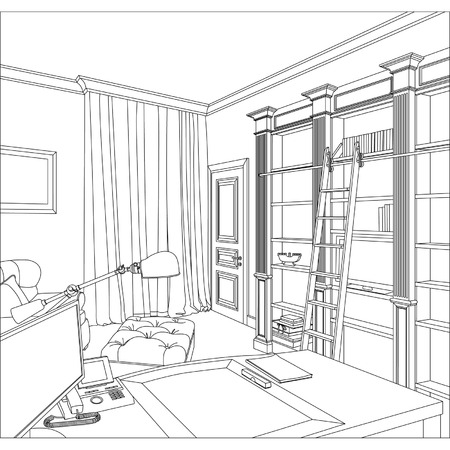Understanding Your Flat’s Natural Light
When looking to brighten up your flat without breaking the bank, the first step is to understand how natural light moves through your space. Start by taking note of where and when sunlight enters each room throughout the day. Is your living room flooded with morning sun, or does it catch the last golden rays in the evening? The orientation of your building—whether it faces north, south, east, or west—plays a crucial role in the type and amount of light you receive. South-facing windows typically enjoy more consistent daylight in the UK, while north-facing ones can be a bit dimmer and cooler. Window size and placement also matter; larger panes or bay windows may let in more sunshine, but even small sash windows can make a difference if used cleverly. By carefully observing these factors, you’ll gain a clearer idea of which areas could benefit from a few thoughtful design tweaks to maximise the available natural light.
Strategic Use of Colours and Finishes
When it comes to making the most of natural light in your flat, one of the simplest and most cost-effective strategies is selecting the right colours and finishes for your walls, ceilings, and floors. The science is straightforward: lighter surfaces reflect more sunlight, helping to distribute brightness throughout your space. Here’s a closer look at how careful choices can amplify light without straining your budget.
Wall Colours: More Than Just White
While classic white remains a popular choice for maximising daylight, there are several subtle variations worth considering. Soft neutrals—such as off-whites, pale greys, and gentle creams—can create a warm but airy feel that reflects natural light effectively. If you want to add a bit of character without sacrificing brightness, consider muted pastels like powder blue or sage green.
| Colour Option | Effect on Light | Typical Ambience |
|---|---|---|
| Pure White | Maximum reflection | Crisp, modern |
| Warm Cream | High reflection | Cosy, inviting |
| Pale Grey | Moderate reflection | Contemporary, calm |
| Pastel Blue/Green | Good reflection with colour accent | Fresh, tranquil |
Paint Finishes: Finding the Right Sheen
The finish of your paint also makes a significant difference. Matt finishes absorb more light and tend to mute brightness slightly; in contrast, silk or eggshell paints have a slight sheen that helps bounce light around the room. Reserve high-gloss finishes for accents or woodwork—using them on walls can be overpowering in small spaces.
Recommended Paint Finishes for Flats:
- Matt: Best for ceilings and low-traffic walls where subtlety is key.
- Silk/Eggshell: Ideal for living spaces and hallways; balances durability and reflectivity.
- Satin/Gloss: Use sparingly on trims or feature walls to highlight architectural details.
Flooring Choices That Enhance Light
Your flooring plays a surprisingly large role in reflecting natural light. Lighter woods (such as ash or birch), pale laminates, or neutral-toned carpets can all help brighten a room compared to darker alternatives. If replacing flooring isn’t an option, consider adding a large, light-coloured rug to bounce more daylight upwards.
| Flooring Type | Light Reflection Level | Suits Which Rooms? |
|---|---|---|
| Pale Timber/Laminate | High | Lounge, bedroom, hallway |
| Neutral Carpet (beige/grey) | Moderate–high | Bedroom, living area |
| Ceramic Tiles (light shades) | Very high (especially gloss) | Kitchens, bathrooms |
| Pale Rug on Dark Floorboards | Adds reflection instantly and affordably | Lounge, bedroom, dining area |
A Practical Note on Budget-Friendly Solutions:
You don’t need to undertake major renovations to see results. Sometimes simply repainting with a higher-sheen finish or strategically placing lighter rugs can make all the difference. By understanding how colours and finishes interact with natural light, you can create a brighter home environment that feels both welcoming and distinctly British in character—all without overspending.

3. Smart Furniture Placement and Selection
Making the most of natural light in your flat often comes down to clever choices in furniture arrangement and selection. Start by keeping larger or bulkier pieces—like sofas or bookshelves—away from windows and direct light paths. This prevents them from blocking valuable daylight. Instead, opt for lower-profile furniture near windowsills, allowing sunlight to travel further into your living space.
When selecting pieces for your UK flat, prioritise those with reflective surfaces such as glass, polished metal, or high-gloss finishes. For example, a mirrored coffee table or chrome-legged chairs can bounce daylight around the room, brightening even the gloomiest corners. Lightweight and translucent items are particularly effective; think glass dining tables, acrylic sideboards, or open-backed shelving units. These allow both light and sight lines to flow more freely, giving the illusion of a larger and airier flat.
Consider multi-functional furniture with slender frames—Scandi-style designs work well in British homes—so you avoid crowding out precious light while maximising utility. Modular seating or nesting tables are practical options that adapt to small spaces without dominating them.
Lastly, keep soft furnishings light in colour and fabric weight. Sheer curtains in off-white or pastel shades filter sunlight gently without sacrificing brightness, which is ideal for the often overcast UK climate. A few thoughtful tweaks to your furniture layout can make a remarkable difference to how bright and welcoming your flat feels throughout the day.
4. Window Treatments for Maximum Daylight
Making the most of natural light in your flat often comes down to selecting the right window treatments. In the UK, where privacy is paramount yet daylight is precious, choosing cost-effective solutions that suit both needs is key. Here’s a practical guide to affordable blinds, curtains, and other treatments specifically tailored for British flats.
Blinds: Function Meets Affordability
Blinds are an excellent choice for maximising daylight while maintaining privacy. Venetian and roller blinds, in particular, allow you to adjust slats or fabric height to let light in without sacrificing seclusion. Opting for lighter colours and sheer materials can help diffuse sunlight deeper into your rooms.
| Type | Best For | Cost Range (per window) | UK Suitability |
|---|---|---|---|
| Venetian Blinds | Precise light control | £10–£40 | Popular in city flats |
| Roller Blinds | Sleek, minimal look | £8–£30 | Good for small windows |
| Vertical Blinds | Larger windows or patio doors | £15–£50 | Common in modern builds |
Curtains: Layering for Light and Privacy
Curtains remain a staple in British homes for their versatility and warmth. For flats with smaller windows or limited wall space, consider lightweight fabrics such as voile or linen—these allow sunlight to filter through while still providing daytime privacy. Pairing sheer inner curtains with heavier drapes offers flexibility: open up completely during bright spells, or layer up when you need a cosier feel or extra insulation on chilly evenings.
Tips for Maximising Daylight with Curtains:
- Mount curtain rods higher and wider than the window frame to let more light in when drawn back.
- Avoid thick, dark fabrics for everyday use; reserve them for secondary layers if needed.
Alternative Treatments: Films and Frosted Options
If your flat faces a busy street or neighbouring property, privacy films or frosted window stickers are low-cost alternatives that don’t block out sunlight. These can be cut to size, applied directly onto glass, and removed without leaving residue—a practical option for renters who want to brighten up north-facing rooms or bathrooms.
| Treatment Type | Main Benefit | Approximate Cost per Window |
|---|---|---|
| Frosted Film | Total privacy with full daylight | £6–£15 |
| Sheer Voile Panel | Softer daylight diffusion, partial privacy | £7–£20 |
Conclusion: Smart Choices Go a Long Way
You don’t have to break the bank to optimise natural light in your flat. With thoughtful selection of blinds, clever curtain layering, and strategic use of films or sheers—all readily available across the UK—you can boost both brightness and comfort whilst keeping your living space private and inviting.
5. Incorporating Mirrors and Reflective Accessories
Strategically placing mirrors and metallic décor is one of the most effective, low-cost tricks for maximising natural light in your flat. By reflecting daylight deeper into your living space, these elements create a brighter and more inviting atmosphere—even on those typical overcast British afternoons.
Mirror Placement for Optimal Light Distribution
The classic approach is to hang a large mirror directly opposite or adjacent to your windows. This tactic captures incoming sunlight and bounces it back across the room, doubling its impact. For rooms with limited window space, consider positioning smaller mirrors at angles where they can pick up and scatter any available light. Hallways and alcoves especially benefit from this technique, as they’re often starved of natural brightness.
Choosing Reflective Accessories
It’s not just about wall-mounted mirrors—other reflective surfaces work wonders too. Think glass coffee tables, metallic picture frames, or polished brass ornaments. These accents subtly catch and amplify light throughout the day, adding both style and luminosity without overwhelming your décor.
Avoiding Overkill
While it’s tempting to fill every surface with shiny objects, moderation is key. Too many reflective pieces can make a space feel cluttered or disjointed. Instead, select a handful of well-placed items that complement your overall design scheme for a balanced and cohesive look.
Experimenting with mirrors and metallic accessories is a simple yet impactful way to harness every drop of daylight available in your flat. With thoughtful placement and a keen eye for detail, you’ll find your home feels lighter, airier, and unmistakably more welcoming—even on those grey London mornings.
6. Clever Use of Plants and Greenery
Integrating indoor plants into your flat is a straightforward and cost-effective way to enhance natural light and create a calming, welcoming space. In the often changeable British climate, certain houseplants are particularly well-suited to thriving indoors while also contributing to a softer, filtered quality of daylight.
Choose the Right Plants for British Homes
Look for species that flourish in moderate sunlight or indirect light—think peace lilies, spider plants, and English ivy. These varieties are not only hardy enough to survive the UK’s lower light levels during winter months but also help diffuse harsh rays on sunnier days. Ferns and snake plants (Sansevieria) are also excellent choices for their air-purifying qualities and resilience.
Strategic Placement for Maximum Impact
Arrange your plants on window sills, shelves, or hanging baskets near natural light sources. Grouping several smaller pots together can create a lush focal point without blocking precious daylight. For north-facing rooms, opt for lighter-leaved plants that reflect more light and keep the atmosphere bright.
Softening Light and Creating Ambience
Plants with broad or trailing leaves—like pothos or philodendrons—gently filter sunlight as it enters, reducing glare and casting attractive shadows across your interior. This subtle interplay of light and greenery can make even compact London flats feel more spacious and tranquil. For a truly inviting touch, consider a trailing plant above a window or a tall leafy specimen in an underused corner to draw the eye upwards and make the most of vertical space.
By carefully selecting and positioning indoor plants suited to British interiors, you can enhance both the look and feel of your flat. Not only do they introduce texture and colour, but they also work harmoniously with natural light to create a softer, more inviting living environment—all without breaking the bank.
7. Embracing Minimalism to Reduce Clutter
One of the most effective—and cost-free—methods for enhancing natural light in your flat is to embrace minimalism. A clutter-free environment not only looks tidier but also allows daylight to flow unobstructed through your living spaces. Start by evaluating each room and removing items that are no longer needed or rarely used. Be honest with yourself: do you really need three spare mugs, or a stack of old magazines blocking the window sill?
Consider adopting practical storage solutions, such as under-bed containers or wall-mounted shelves, to keep necessary belongings out of sight yet easily accessible. Choose furniture with clean lines and slim profiles, as bulky pieces can absorb both space and light. If possible, position larger items away from windows to prevent them from casting shadows or blocking the incoming sun.
For decorative touches, opt for just a few well-chosen accessories rather than many small trinkets. This approach not only keeps surfaces clear for light reflection but also imparts a sense of calm and order. Remember, open floors and bare walls reflect more sunlight, making even compact flats feel airy and inviting.
If you’re prone to accumulating bits and bobs, try setting aside time each month for a quick declutter session. Donate unwanted items to local charities or list them on neighbourhood apps like Nextdoor or Freecycle—both popular across the UK. By regularly reassessing what you truly need, you’ll maintain an open environment that maximises every ray of available daylight.


